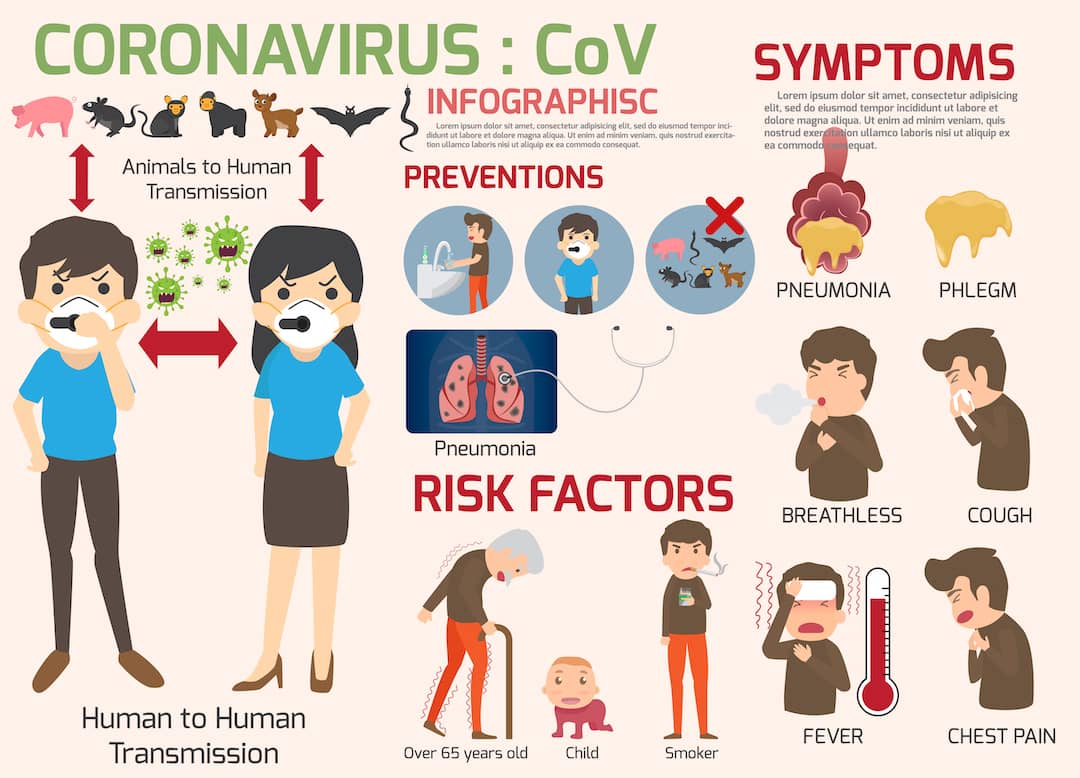The Coronavirus – What You Need To Know
Originating in China, the 2019 Novel (new) Coronavirus (2019-nCov) is fast spreading. Though it’s not yet a global concern, it may soon become one.
With a current death toll of 80 and nearly 3000 reported cases, health experts worldwide are working tirelessly to contain the situation. Recently, it was confirmed the virus could jump from human to human.
What is Coronavirus?
Coronavirus is several viruses causing severe illnesses in mammals, including humans and birds. These illnesses range from mild to severe affecting the respiratory system of humans. Other serious symptoms include kidney failure, pneumonia, and even death.
Where did the Virus Originate?
Reports suggest Severe Acute Respiratory Syndrome (SARS-CoV) can be transmitted from civet cats to humans, and the Middle East Respiratory Syndrome (MERS-CoV) from camels to humans. The SARS and MERS are the most severe syndrome and have killed more than 1500 people between them.
There are several other known coronaviruses present in animals that have not yet been transmitted to humans. Currently, only six coronaviruses have been identified in humans.
However, novel coronavirus, also known as the 2019-nCoV, is a new strain not previously found in humans.
The Novel Coronavirus
This strain of coronavirus was recently documented on the 31st of December 2019 in Wuhan city, Hubei Province, China. Authorities confirmed the virus belonged to the family of coronavirus that includes the common cold and other viruses such as SARS and MERS.
Reports suggest the 2019-nCoV likely originated in snakes – the many-banded Krait (Bungarus multicinctus) and the Chinese cobra (Naya atra). However, many experts have debunked this report. They claim it’s unclear if coronavirus can affect snakes.
Further investigations are ongoing in Wuhan in the local seafood and animal markets where health officials speculate the virus likely got transmitted from animals to humans.
A study recently published in the journal of Medical Virology reveals a change occurring in one of the viral proteins in 2019-nCoV can cause the virus to bind to receptors in specific host cells. Researchers believe the change in this protein could have helped the virus get transmitted to humans.
How Far has the Virus Spread?
After reports in Wuhan, China, on Dec 31st, the virus has rapidly spread to other countries, including Japan, Australia, Thailand, Taiwan, France and the U.S.
The first case of the novel coronavirus was reported in a middle-aged man who had recently returned from Wuhan to Canada. In the U.S, it was first documented in the state of Washington on Jan 21st, 2020, affecting a man. The second case, a few days later, was reported in Chicago affecting a woman, and the third documented case, according to health officials, was a man in Orange County, California, who tested positive to the new coronavirus.
The youngest reported case was recorded in Beijing, affecting a nine months old girl.
Consequently, The New York Times reports the Chinese government has stopped most of the travel from Wuhan and twelve other nearby cities.
Thailand and Hong Kong have the highest reported infection cases of eight after China, while the U.S, Taiwan, Australia, and Macau each have five. Singapore, Japan, South Korea, and Malaysia have also reported four cases each. Nepal has the lowest number with only one reported incident so far.
Also, the Taiwan and Hong Kong governments announced they will not allow anyone in from the Hubei province. Similarly, in the U.S, major airports are conducting screening to make sure passengers aren’t infected.
Coronavirus Symptoms
The virus affects the upper respiratory system with some of the symptoms including:
1. Cough
2. Sore throat
3. Runny nose
4. Headache
According to the World Health Organization (WHO), the 2019-nCoV causes fatigue, dry cough, fever in the early stages and difficulty breathing as it progresses. Usually, these symptoms may not manifest until a few days after contracting the virus.
Coronavirus in the U.S
According to reports on January 26th, 2020, two new cases of the virus were found, bringing the total number currently recorded in the U.S to five. The new cases were documented in California and Arizona.
Health officials and the Centers for Disease Control and Prevention (CDC) expect to see an increase in the number of cases in the coming days and weeks. Currently, investigations are being carried by the CDC in about 60 people in 22 states for possible infection with the new virus.
How many People have the Virus?
There are over 2,700 reported cases currently. In addition to China and the U.S, there were also confirmed cases of the virus in Australia, France, and other Asian countries. According to the New York Times, 80 deaths were linked to the 2019–nCoV virus.
Can the Virus Spread between Humans?
According to the CDC, the primary mode of transmission is from animals to humans. However, the coronavirus can be transmitted from one person to another.
The standard way of transmission between an infected person and others include:
- Through viral particles from sneezing and coughing.
- Physical contact with the infected person including touching of hands.
- Contact with contaminated objects such as door handles.
- Fecal contamination.
Symptoms of Novel Coronavirus
The coronavirus has symptoms similar to SARS, such as cough, running nose, and difficulty in breathing. However, there are some notable differences from SARS symptoms like the absence of respiratory tract symptoms such as running nose, sore throat, sneezing, and intestinal symptoms like diarrhea.
Who is at Risk of becoming Infected?
However, according to Dr. Adam Kucharski, a professor at the London School of Hygiene, people with preexisting illnesses, and the elderly are more at risk of contracting this virus.
The risk of transmission in young people with thriving health is currently unknown.
Treatment
There is no treatment for coronavirus just as there isn’t any treatment for the common cold.
Most people will likely recover without medications. However, if you’re anxious about your symptoms, you should visit your health care provider.
With China’s prompt sharing of the virus’s genetic code, researchers at The U.S National Institute of Health are currently in the preliminary stages of developing a vaccine. Also, Regeneron, a drug company, has announced the development of a treatment for the virus, according to NBC News.
How to Protect Your Family
1. Avoid travel to Wuhan, China, and the surrounding cities.
2. If you are traveling to China, avoid contact with sick people. Keep away from dead or live animals as well as products from dead animals such as uncooked meat.
3. Wash your hands regularly.
4. Properly cook meats and eggs.
5. Avoid contact with anyone experiencing respiratory distress such as sneezing and coughing.
6. Make sure you cover your mouth and nose when coughing and sneezing.
Where to Get the Latest Information
The CDC and WHO is closely monitoring the outbreak caused by the new 2019-nCoV virus. The latest information and updates will be on their websites.
A viral pandemic is just one of the several emergencies your family could face. Have you ever wondered what will happen if suddenly you and your family were gripped by a tornado or a raging fire? It has rightly been exclaimed prevention is better than cure.
So, before an emergency affects your family, it’s in your interests to plan your family’s preparedness.






